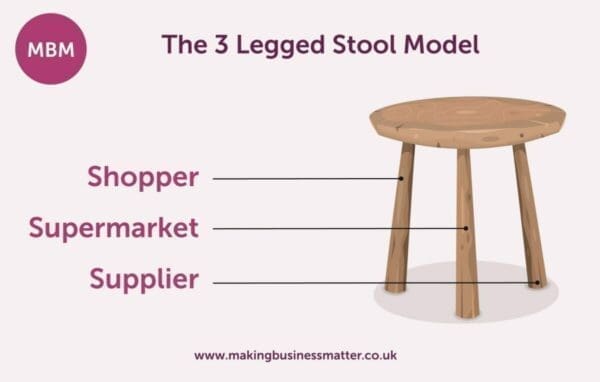What is Category Management?
Let’s break down the words of a Category Management Strategy. Then we’ll take a look at how to develop a Category Management strategy.
Category Management’s origins lie in the late 1980s, following the innovative work of Brian F. Harris. Significantly, Harris dismantled the previous reigning ‘supplier vs supplier’ ideology. Which encouraged them to work together and hone their focus onto consumer needs in respect of the retail decisions that were being made.
Previously as brand A promoted their products, brand B’s sales would decrease. A thrives in B’s plight. Consequently, there was no net gain for the retailer; a change was needed. For the first time, the retailer grouped the range of products offered for sale together. These groups were based upon product similarities and the consumer needs they met. Here, decisions were made with the shopper at the core, in the hope to meet their needs and maximise retailer profits.

What is a Strategy?
A strategy is fundamental if you want to achieve a long-term goal. It is a lens we all employ in the runnings of day-to-day activity. We strategise the best resources we can utilise to achieve our end goals, whether it’s for today, tomorrow, or further in the future. So, in the context of business, a strategic framework is imperative. Without it, one’s organisation will become overwhelmed and run in too many different directions with no clear end goal.
It is essential to remember that a strategy is the product of a detailed planning process, thus an organisation needs a thoroughly developed plan to succeed in its quest to reach its desired future state. A strategy is a little like a skeleton, providing the ‘backbone’ for which the meat of the plan can be added. Our article on ‘thinking strategically’ will help.[/vc_column_text]

What is a Category Management Strategy?
Here at MBM, we have devised the Category Management funnel to help Category Managers focus and to truly understand what is important. This funnel strategy helps Category Managers to develop greater shopper understanding. Subsequently helping them to increase the landing rate of opportunities that reach the store. A process that is there to ‘1. Identify, 2. Sell and 3. Land’ more opportunities for their categories.

7 Layers
The Category Management process funnel has 7 layers:
1. Agree on the Category Targets – without targets, and without ‘thorough planning’, you will have no idea where or what direction you are heading.
2. Understand Your Shopper – rather than focusing only on the ‘in-store shopper’, you need to look at the larger picture, the bigger shopper; those users of a product with a need being met… the Shopper, the Preparer and the Eater.
3. Know Your Supermarket – ensure that your Category Management is aligned to the goals and needs of your supermarket.
4. Turn Analysis & Understanding into Opportunities – do not just regurgitate data because you will fail to discover deep insight and category opportunities. You need to identify hypotheses before your analysis as this will lead to more focused category sales opportunities.
5. Sell £ Opportunities to Supermarket – a hurdle many fall at. Think of alternative ways to engage your buyer. You have spent many hours identifying your opportunity so don’t waste this by presenting a 100-page slideshow for hours on end.
6. Land Opportunities In-Store – Your recommendations to your buyer cannot just look good on paper, they also need to land well in the store.
7. Evaluate and Improve your Category Management Process – do not just blindly move not the next project without knowing how to make that next project better. You must understand how to measure your performance as a Category Manager and to always improve.
How to Develop a Category Management Strategy?
In short, to develop a Category Management strategy, follow the funnel. Because you can use the skeleton of the 73% Funnel for a product, a subcategory, or an entire category.
There are 7 steps (layers to follow):
1. Agree on the Category Targets
Identify, as a category team, whether the biggest and most realistic opportunity exists within ‘WOP, FOP, or PEN’. To ‘go after’ Weight of Purchase’, or ‘Frequency of Purchase’ or Penetration’. In other words, to try to get the current shoppers to buy more (WOP). To get the current shoppers to buy more frequently (FOP). Or to get more shoppers (new) to buy the category (PEN).
2. Understand Your Shopper
Using the above targets as a guide, understand what would A. Encourage shoppers to do more of what you want. I.e. buy more frequently, if you chose a frequency target. And B. what holds them back from buying more. The answers might be different.
3. Know Your Supermarket
Understand what your supermarket/retailer wants to do with this category. Whether they agree with the category target you suggest and the reasons why shoppers do and not do what you want them to do.
4. Turn Analysis & Understanding into Opportunities
Using the category target as a guide, the shopper insights you have gained, and the supermarket’s input, test your hypothesis by analysing the data. For example, we chose to target frequency and to increase it from 4.1 trips per year to 5.1 trips per year. To achieve this the supermarket agreed that we would employ 3 tactics.
5. Sell £ Opportunities to Supermarket
Having analysed and modeled the hypothesis above, share the plan with the supermarket, how the category performance will improve, and what action you need from them.
6. Land Opportunities In-Store
Execute your plan in-store being mindful that implementation in-store must be practical, reviewed regularly, and adapted. Not launched and left.
7. Evaluate and Improve your Category Management Process
Use a two-weekly dashboard to track the changes in the category performance vs the targets, and also to update & discuss any deviations from the plan with the category team.
Check out our category management training course.
[/vc_column_text][/vc_column][/vc_row]


